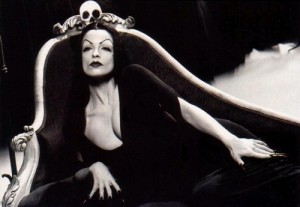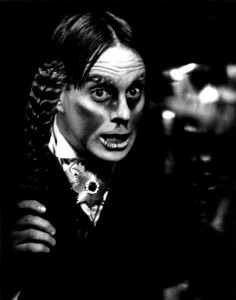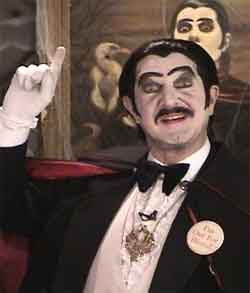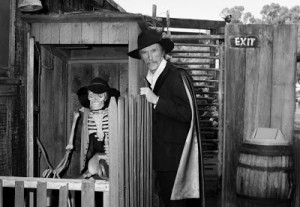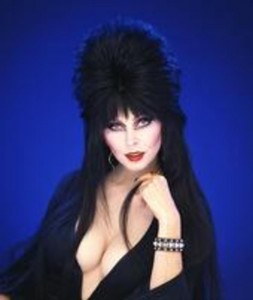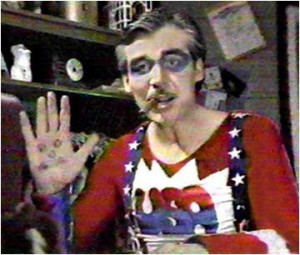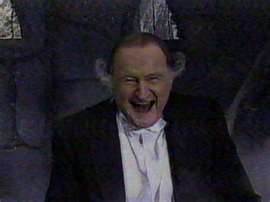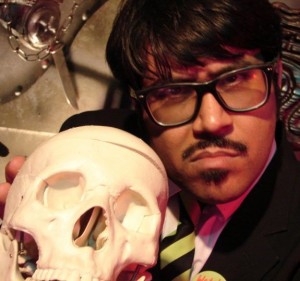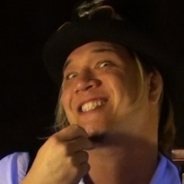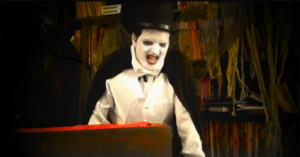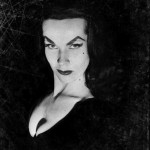 As we continue on through the Halloween season I thought that now would be the perfect time to cover the grand tradition that is the Horror Host. To bring any newcomers to the concept up to speed, Horror Host is the general term used for a character that would host late night horror movies often called creature features.
As we continue on through the Halloween season I thought that now would be the perfect time to cover the grand tradition that is the Horror Host. To bring any newcomers to the concept up to speed, Horror Host is the general term used for a character that would host late night horror movies often called creature features.
The genesis of both the Horror Host and creature feature is interesting. Back in the 50’s local station were always looking for cost effective programing to air, as well as trying to bring in viewers.
In 1953 actress Maila Nurmi attended a Los Angeles masquerade dressed as Morticia Addams. A local TV producer saw her there and had the inspiration to have her host horror movies on his station. Making alterations to the look and manner of the costume to avoid copyright issues Nurmi created the character of Vampira, and is credited as being the first Horror Host. The original show only lasted a year, but Nurmi made sure she owned Vampira and was able to bring the character back on a different station a year later. The ghoulish manner and macabre puns she used became the blueprint for all the Horror Hosts to follow.
Nurmi may have set Horror Host template, but it was production company Screen Gems that assured that they would be an American institution. In 1957 Screen Gems was the television subsidiary of Columbia Pictures, and had syndication rights to over 50 Universal Horror films. These films were marketed as a cost effective syndication package called Shock to local stations. As part of the package the stations were encouraged to have a host following the style that Vampira had set. Many markets called their show Shock Theatre after the name of the package. There would be a later package in the 60s called Creature Feature, and due to its rhyming nature it became the generic term for the show type.
John Zacherle was hired as the Horror Host for a station in Philadelphia. He created the character of Roland, a cross between an undertaker and a mad scientist. Later incarnations of this character were called Zacherley. Zacherle would take the macabre humor and ramp it up, including having Roland break in during the middle of a sequence of the film doing something odd or ghoulish and then go right back to the film. Zacherle would also go on to do things like record a novelty song called Dinner with Drac. Dick Clark gave him the nickname the cool ghoul. If Vampira set the stage for Horror Hosts then Zacherle codified how to do it.
Most stations had purchased the Shock package, and later Creature Feature as a means of low cost programing. Since they were interested in keeping costs down the Horror Host was often an employee of the station who did an off-screen job such as an announcer or program director. Sometimes it would be an on-air talent such as a weather man.
A great example of this type of Horror Host is Count Gore De Vol. Dick Syszel who played the count was an announcer at a Washington DC station. The character of Gore De Vol debuted in 1973. Syszel took the standard Horror Host routine and upped the ante. As he was in the nation’s capital he would often include political humor. De Vol was also one of the earliest, if not first, Horror Hosts to regularly include sexual innuendo as part of the act.
One other early Horror Host that deserves mention is Sinister Seymore. Seymore was played by actor Larry Vincent and hosted a show called Fright Night for a Los Angeles station. Seymore would use the Zacherle model of interacting with the movie, but instead of a cutting to him he would either appear in a pop up screen in the corner of the film to make a remark or blue-screening himself directly into the movie. He was also clearly an inspiration for the character of Peter Vincent in the movie Fright Night. Vincent played Seymore until his death in 1974.
Six years after Vincent passed the station decided to revive the show, and looked for a new Horror Host. The person they found became the Horror Host that is almost universally known, Cassandra Peterson better known as Elvira, Mistress of the Dark.
Elvira combined aspects of many of the Horror Hosts that came before. Her look harkened back to Vampira, she did break ins like Roland, she had innuendo like De Vol, and she added a sharp wit. Peterson would go on to do several acting gigs as Elvira including headlining two movies as the character.
A lot of the Creature Feature shows in the early to mid-eighties saw their viewer base erode since they were on Saturday late night and the audience was being drawn away by Saturday Night Live. On top of this it became harder for stations to afford to pay broadcast rights for the old horror movies as they became more expensive with the rise of cable stations. However there were some notable exceptions
One was Commander USA’s Groovy Movies on the USA Network. Unlike the traditional Horror Host Commander USA, played by actor Jim Hendricks was a blue collar superhero, and would play the character more in the style of an old Kids show host. Another difference is that the show would run on Saturday and Sunday afternoons. The show ran from 1985 to 1989 and produced 200 episodes.
Around the same time as Commander USA, TBS had Al Lewis host an afternoon creature feature show as Grandpa Munster. Due to copyright issues, even though he wore the same basic costume that he did on the Munsters, Lewis’ character was only called Grandpa.
One other show that I would be remiss if I did not mention was of course Mystery Science Theater 3000. Originally a creature feature show for a station in Minnesota, the shows premise of riffing throughout the program, rather than the break-ins practiced by Roland and Seymore, brought it to the attention of the newly started Comedy channel, which later became comedy central.
When MST3K went off the air in 1999 it seemed that the era of the Horror Host was over. Most local stations found the broadcast price for the movies too expensive and the cable networks had moved on to other programing. While it appears that there was never a time without a Horror Host, the tradition appeared to be fading.
But it is hard to keep a good ghoul down, and the Horror Host as American icon was too strong to stay down long. By the mid-2000s you saw new Horror Hosts spring up, either on local station or on Internet broadcast. These shows dealt with the broadcast rights issue by showing public domain films. One show, Cinema Insomnia hosted by Mr. Lobo, managed to get a syndication deal. Elivra has also returned using a similar format
The Horror Host image is one that has become such a part of our culture that it shows up in many interesting places, especially around Halloween. Back in my Halloween Horror Nights article I talked about their use of characters they call the Horror Icons. Most of those characters have the qualities of a Horror Host. Last year they had a house called H.R. Bloodengutz where a Horror Host goes mad and starts terrorizing the station.
With such a history it should not be surprising that web series have also used the Horror Host. Internet Reviewer Jack Shen reviews horror movies as Count Jackula, who refers to himself as a Horror Host.
Just this month popular reviewer Lewis Lovehaug, who hosts comic book review show Atop the Fourth Wall, has started a new daily review show for the month of October called Longbox of the Damned. In it Loevhaug does a five minute overview of horror comics as Horror Host Moarte. Moarte embraces all the tropes of a Horror Host and would not be out of place on late night TV.
Clearly I have only scratched the surface of Horror Hosts here. And I found that people will feel a real connection to the host they grew up with. For me it was a character on the local Seattle station called simply the Count. He was a very generic Dracula rip-off, played by Joe Towey who directed the stations kids show, but I still have strong memories of the show as a child, and I did grow up loving the old horror films. Other friends of mine who grew up elsewhere were enthusiastic about their horror hosts including Gore De Vol, Sir Graves Ghastly, Ghoulardi, Joe Bob Briggs, Bone Jangler, and Penny Dreadful.
If you are interested in learning more, many hosts have a Facebook presence and have become a well networked community. I also came across a great blog called the Non-productive Network. The do a great series covering individual Horror Hosts.
So it looks like the Horror Host is here to stay. Who knows maybe one day I can finally produce Dr. Caliban’s Nightmare Theater.

